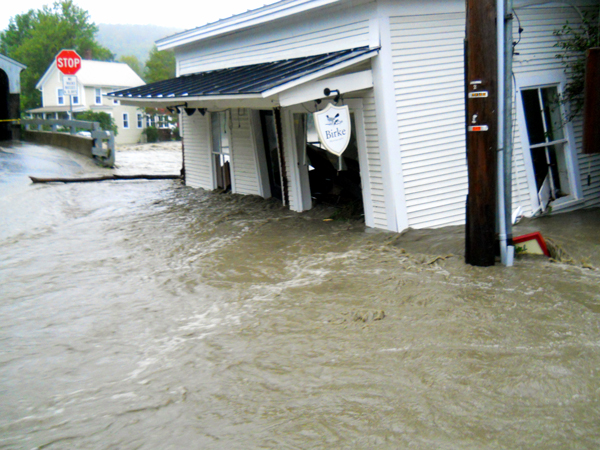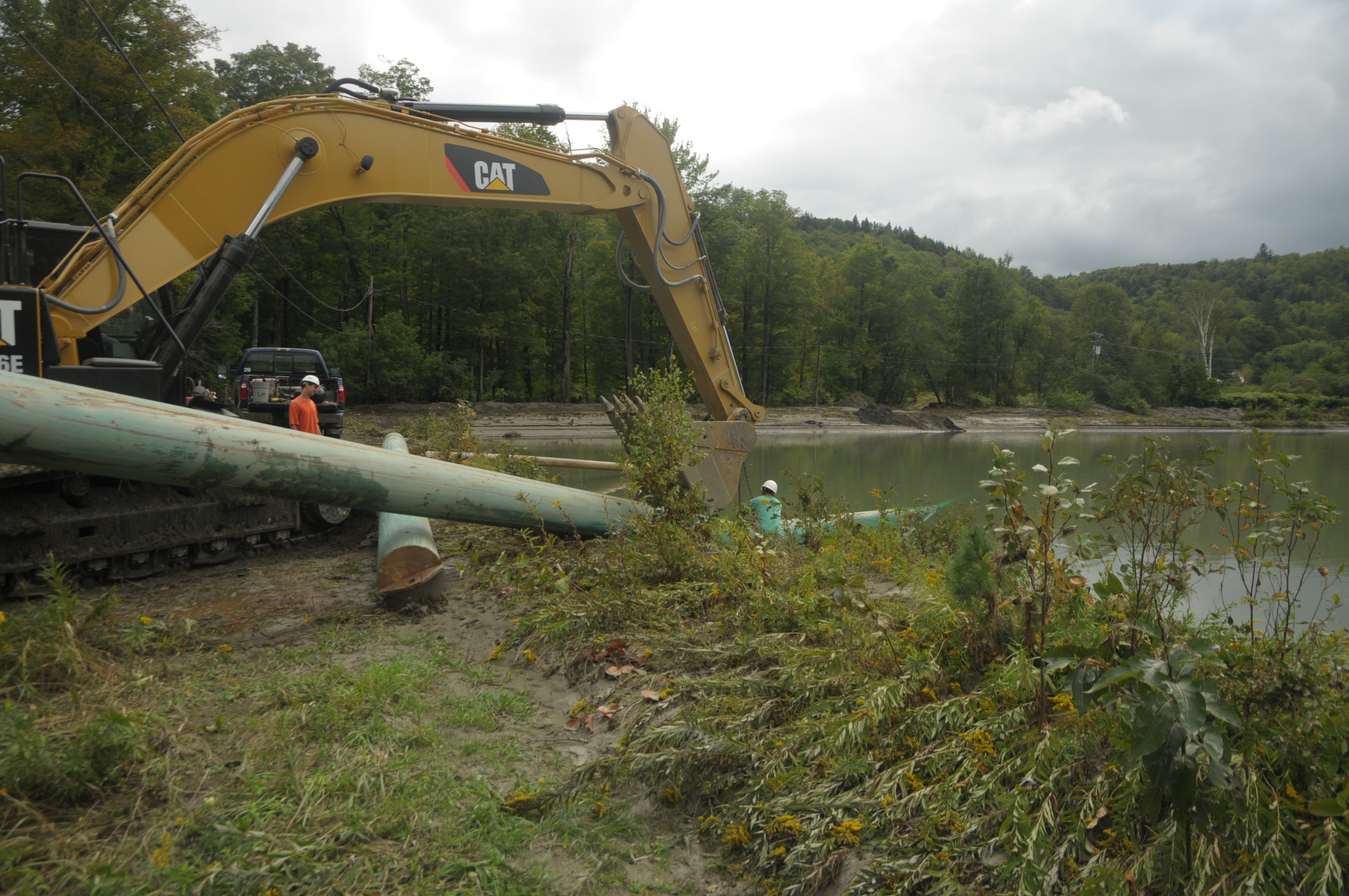In the words of Harwood Union chanteuses Liza Mackey and Naomi Koliba, Irene was “really, really, really, really, really, really, really, really mean” to The Valley, Waterbury and Vermont.
Mackey, whose Duxbury home was flooded, and Koliba wrote and sang their post-Irene song at a Harwood Union assembly when the high school opened several days late due to the August 28 flooding.
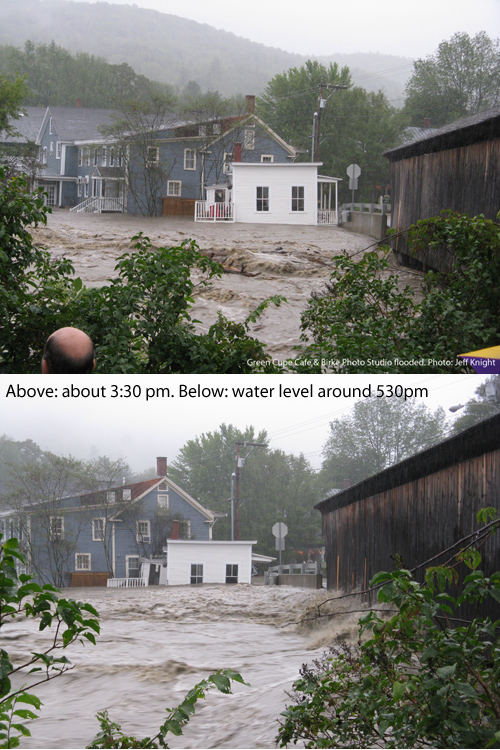
They were right, Irene was really mean to the area, destroying homes and offices, drowning businesses, completely washing away roads and bridges, isolating towns and leaving a swath of destruction that rivaled the flood of 1927. And by the numbers, in terms of stream flow and flood stage, Irene may have surpassed the flood of 1927.
As overwhelming as the flooding was, so too was the response. A sustained volunteer effort that drew people from next door, Burlington, Boston, New Orleans and many points in between got underway immediately the morning after the flood. Road crews and every available operator of heavy equipment began working to make roads passable. People made the overland trek down to Granville, Hancock and Rochester where an entire community was stranded with no access from any direction from Sunday until Wednesday.
The Mad River Valley Community Fund kicked into high gear as donations began to pour in. Fundraisers were scheduled and held with great success. The volunteer work continues as volunteers and contractors work to help get people back into their homes and businesses open again. What follows are summaries of some of the major aspects of Irene.
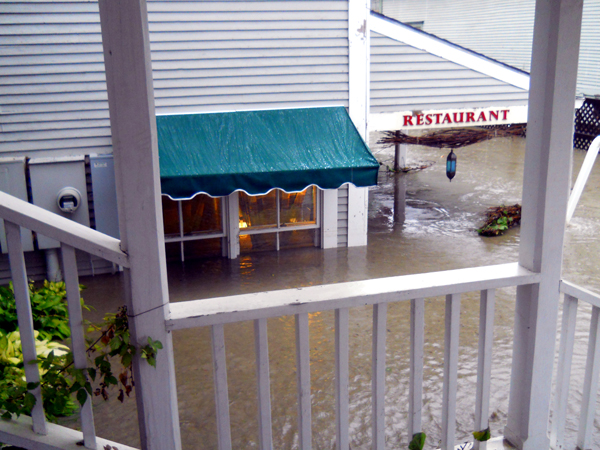
Irene wrecked homes and businesses
From Warren to Moretown and on to Waterbury, Irene’s floodwaters surged through homes and businesses, filling basements with water and leaving heavy muddy sludge when the waters receeded. In Warren, several homes were flooded in the village and along Route 100. At The Pitcher Inn, the Tracks bar was destroyed along with hundreds of bottles of wine in The Pitcher Inn’s wine cellar. Tracks re-opened this month.
Floodwater swept over Mad River Massage and Valley Dental. Both buildings were deconstructed down to the studs and reconstructed. Mad River Massage is open with work continuing on the first-floor space. Valley Dental is being wrapped in a rubber bladder and is expected to be open after the first of the New Year.
Bridge Street bore the brunt of the flooding in Waitsfield with the entire Bridge Street Marketplace taking a hit. The Fuller House took water, Artisans’ Gallery took on water, the red building that housed MRVTV took on four to five feet of water, destroying the local public access television channel’s studios and every piece of equipment as well as that of the Architectural Association. (MRVTV has re-opened at the north end of the Village Square Shopping Center.) The white building, the Waitsfield Hotel that housed MINT, saw the entire first floor flooded. MINT has not yet re-opened but its owners have been serving lunch from the basement of the Waitsfield church on a donation basis.
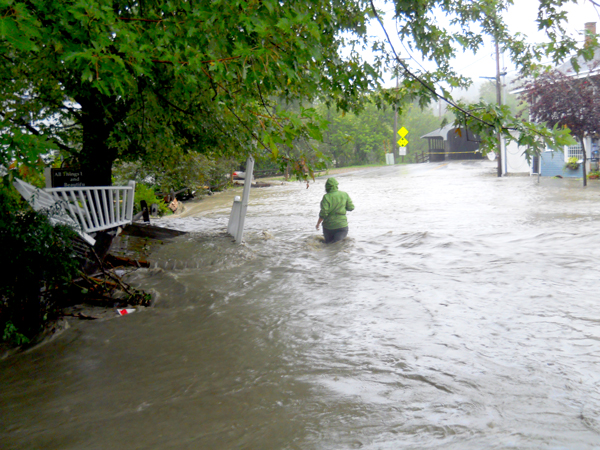
Artisans’ Gallery is open, along with the Bridge Street Emporium and All Things Bright and Beautiful, which had a basement full of water and structural damage to its foundation. The building that used to house Birke Photography, between the Waitsfield covered bridge and the blue building that housed the Green Cup, was lifted off its foundation and destroyed. It was disassembled and is in pieces in the backyard of the Madsonian Museum which was not damaged in the flood. Jason Guilisano, owner of the Green Cup and that building, has been working on reconstruction since the flood, but the future of the restaurant remains uncertain.
Several homes were flooded in Waitsfield and one at the bottom of North Fayston Road was destroyed when Shephard’s Brook jumped its bank and also destroyed five driveways and rerouted itself. At the Riverhouse Condominiums, the flooding rerouted the course of the Mad River, ate a significant portion of the bank at the south end of the condominium property and consumed the backyard of the parcel to the immediate south (along with a truck).
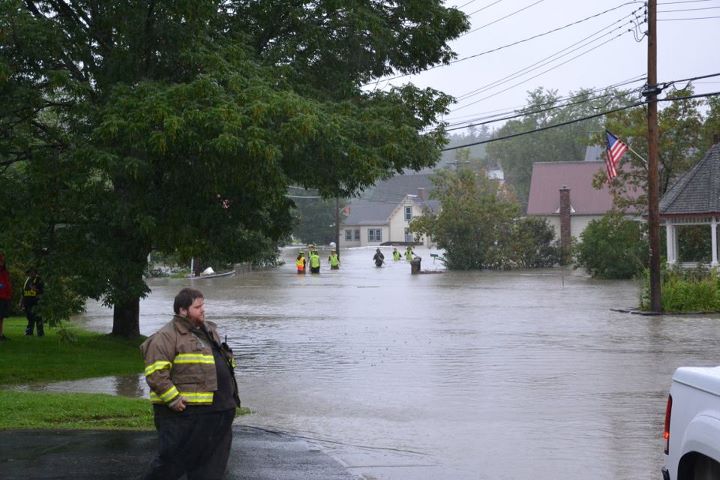
Moretown Village was very hard hit by the flooding with more than 60 homes and buildings flooded, including the post office, the town offices, the church, the school and the fire station.
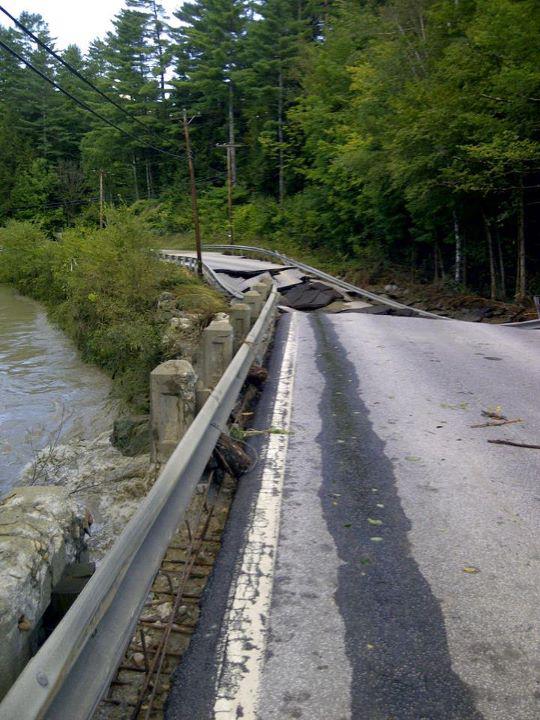
Moretown Village was the focus of intense cleanup work by residents and volunteers in the days following the flood. Some residents are back in their homes while others are still working to get back in their homes. The fire station is back in use along with the school – which opened a week late with students studying in tents donated by Valley Rent-All for the first week. The town records that were damaged when the town office flooded are being restored and the town clerk is operating out of the school. Along Route 2 in Moretown, flooding was severe, damaging multiple homes and several businesses as well.

Waterbury Village and parts of Duxbury suffered extreme damage at the hands of Irene. The state office complex that housed 1,500 state workers was so damaged that parts of it will have to be torn down and a lot of them will need reconstruction. The town suffered the loss of those 1,500 jobs as well as flooding of over 200 homes, buildings and businesses. The town estimates it lost $9.7 million in property valuation due to the flooding. Like Moretown, Waterbury has been a hive of activity since the flooding with some homes and businesses re-opened, and some, like the Alchemist, not re-opening at all. In the weeks following the flood, Revitalize Waterbury and the town leadership formed ReBuild Waterbury. That group has been helping homeowners and businesses with reconstruction.
Irene wreaked the roads
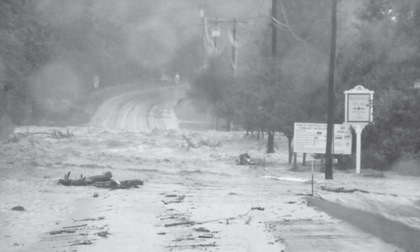
Severe flooding caused by Hurricane Irene damaged several of The Valley’s roads and bridges last August; residents were forced to detour around closed town highways, utilizing alternate routes along dirt roads.
Town road crews and contractors worked around the clock to repair washed out roads and re-open major arteries within days of the flood.
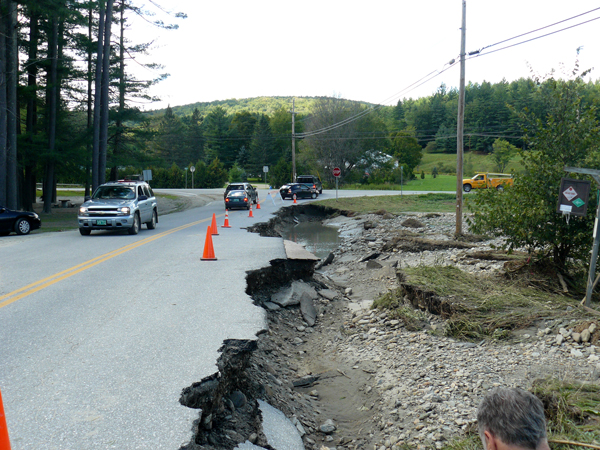
On the Thursday following the flood, town officials from all Valley towns convened at the Big Picture Theater and Cafe to update residents on the status of the road closings. Tremblay Road was closed for a day to repair a rupture in the road after a culvert washed out. Bridge Street was closed to traffic after the Waitsfield covered bridge sustained structural damage.
Following the flood, a preliminary inspection of the covered bridge by engineers from Dubois and King indicated that it was “moderately damaged” by the storm.
Contractors from NorthLand Construction and Kingsbury Construction completed emergency repairs to the bridge that re-opened to thru traffic on November 17. The project cost approximately $19,761.
The Warren covered bridge was undermined by floodwater and closed for repairs for a few weeks; a section of Flat Iron Road washed away and was closed following the flood; town officials made repairing the road among its top priorities and re-opened it a month later.
Senor Road and the lower section of Fuller Hill Road (from Prickly Mountain Road down) was open to one lane only following severe flooding that overwhelmed several culverts. A bridge on Plunkton Road in Warren partially collapsed following the flood; Plunkton Road was closed immediately following the storm.
A sunken abutment left the bridge deck unsupported; once the town re-opened the road, the bridge was damaged by the heavy traffic as a result of the detour route to Granville. A state engineer determined that the bridge was totaled and will need to be replaced. Select board members previously approved Department of Public Works director Barry Simpson’s request to investigate temporary solutions to stabilize the bridge before winter.
Warren town officials voted in favor of hiring certified bridge contractor Blow & Cote to complete a temporary fix for a flood-damaged bridge on Plunkton Road at the November 14 select board meeting. The temporary fix was estimated to cost $56,085.
Simpson told town select board members that the town would provide the backhoe to put a beam in place to fix the bridge temporarily. The cost to replace the bridge could run the town $400,000, Simpson said.
At a special meeting Monday, December 5, Warren Select Board members awarded a bid for the Brook Road stabilization project to JP Sicard; the $287,460 bid came in under Kingsbury Construction’s bid of $384,688.
The project includes stabilizing embankments along Freeman Brook and clearing debris sites from the brook in an effort to prevent Brook Road from destabilizing during heavy flooding.
Simpson said, “There are some places with relatively minor wooden debris, leaning trees that in a flood stage would be engulfed, that they want to leave to retard the flow of the river and also improve the habitat and so forth.”
The intent, according to Simpson, is to reduce the flow of the river at high-flow times by the construction of stone arches that face upstream. There is significant erosion already occurring in the section of Brook Road along Freeman Brook.
State engineers and hydrologists have requested that the town “keep an eye on the site,” given its location next to a road and relatively little ledges, Simpson said.
In Fayston, German Flats Road saw the most significant damage as a result of flooding. Approximately 1,500 feet of gravel and crushed stone was used to fill the blown-out section of road from Hidden Wood Road to the Fayston Elementary School.
Contractors from Kingsbury Construction in Waitsfield along with Fayston’s road crew worked to fill and resurface the road that is open to two-lane traffic.
A culvert that blew out on the lower portion of German Flats was replaced in addition to a blown-out culvert by Slide Brook Road and a ruptured section of Rankin Road. Town road crew members repaired a blown-out section of Center Fayston Road; a section of Bragg Hill Road, part of Number Nine Hill Road and a section of North Fayston Road have also been paved.
In Moretown, the bridge abutment just south of the village was destroyed, leaving residents to detour along Pony Farm Road. A bridge on Spillway Road also washed away, leaving Pat and Scott Sainsbury without vehicular access.
Contractors took extraordinary measures to deliver parts of a temporary bridge to Spillway Road where the original bridge used to be. The temporary bridge was assembled on the far bank of the Mad River after contractors trucked bridge pieces across the waterway.
Contractors went into the river with welding tools to cut the old bridge into pieces and remove it via trailer. A crane pushed the new bridge across the river.
The original bridge was built in 1928 and rebuilt in the 1990s. Extreme flooding during Hurricane Irene destroyed the bridge that lay in the river for weeks following the flood. Town officials opted to install a temporary bridge that serves as Pat and Scott Sainsbury’s only motor vehicle access to their property.
The road from the bridge to the house is Class III, the other road in front of the barn area is Class IV. J. A. McDonald of Lyndon Center was contracted to remove the bridge and install the temporary bridge.
Flooding during Irene also did serious damage to many roads south of The Valley. Churchville Road in Hancock was severely damaged; the dirt road was severely eroded. The only access for those residents, including medical patients who need regular treatments, was via Fiske Road, which runs through Rochester.
Fiske Road was also severely damaged in the storm and received a temporary fix, but there is no assurance that it will last through another storm event and/or the winter. If Fiske Road fails Churchville Road residents will have no way out and fire, police and emergency medical services have no way in. Hancock, Rochester and Granville worked together to upgrade a 500-foot section of a Class IV road, Town Highway 21, to provide access for this winter for Fiske and Churchville Road residents to get to Route 100 and for fuel and emergency vehicles to get in.
Granville had its own serious road issues. Buffalo Farm Road, which comes down to Route 100 by D’s Doghouse, was completely washed out and closed for the winter. Road foreman Kevin Bagley said that the town is working with FEMA on the problems.
“There are quite a few issues with the road. The problems start at the bottom and go all the way up. The road is built on a clay bank and there are three different slides. There is one section of road that has cracked down the center line, along the ditch line and along the bank edge. There are six- to eight-inch gaps in the road that are three to four feet deep and several feet long,” Bagley explained.
Estimates to repair that road range from $750,000 to $1 million.
Asah Rowles who coordinated the flood relief efforts in Granville said that Irene left an estimated 1,000 trees down on Buffalo Farm Road and said that the town hired a retired VTrans employee to help sort through road issues, including FEMA and engineering and repairs.
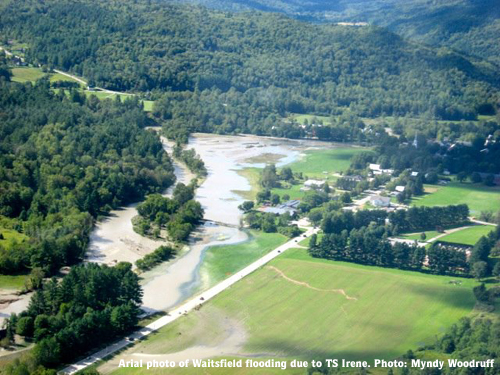
Farms destroyed by flooding and knotweed
Following the havoc Hurricane Irene wreaked on The Valley, many local farmers’ losses were significant. Crops were destroyed and most of the landscape flooded and washed away and area food producers’ growing season came to an abrupt and costly end.
Most all of the meadows at Simplicity Farm in Waitsfield were completed flooded; owner Doug Turner estimated that at least five acres of his pasture was rendered useless for the year. Flooding brought river silt, gravel and sand to an area of pasture where his organic cattle used to graze.
Due to organic certification requirements, Turner’s cows must receive approximately 30 percent of their food matter from grazing and spend 120 days grazing. Turner said they’ve been able to maintain Simplicity Farm’s organic grazing practices, but not without cost.
The bacteria present in river water, silt and sand contaminates the grass and presents what Turner said was a “tremendous challenge to their immune systems.” Turner’s cows continue to follow the guidelines set for organic certification and graze in the available pastures. “Being organic, they have to,” he said. Of the 17 mastitis cases, the vast majority was cured; three were sold for beef because Turner said he can’t help them.
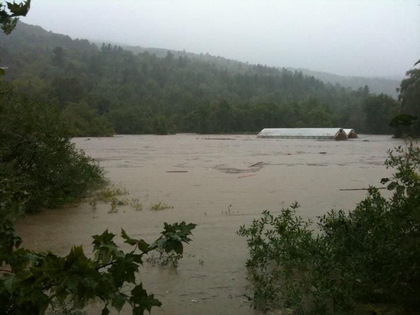
Simplicity Farm sits against over 2,000 feet of riverbank; Turner estimated that it’s going to cost over $100,000 to repair the farm.
Elwin Neill’s farm in Waitsfield also saw significant flooding and crop loss in August. While some of the sweet corn that wasn’t flattened or flooded is being picked and sold, Neill said, “A lot of it we had to walk away from.”
Of the 80 acres of field corn, 15 acres didn’t see any water damage. Neill said the Vermont Agricultural Department doesn’t recommend cutting the corn that was exposed to water due to concerns about micro-toxins that are harmful to cattle if ingested.
The Vermont Agency of Agriculture partnered with the Vermont Community Foundation to create the Vermont Farm Disaster Relief Fund. The purpose of the Fund is to address critical needs of Vermont farms that sustained damage from Hurricane Irene, to help them continue or return to production.
The Kingsbury Market Garden in Warren was the first Vermont farm to receive emergency funding from the Vermont Farm Fund. The Center for an Agricultural Economy (CAE) has administered $35,000 in zero interest loans through the Vermont Farm Fund (VFF) to four Vermont farms of varying size.
Kingsbury Market Garden lost 10 percent of the tillable land to the river, lost a fall planting season to contaminated soil and the bulk of the crops to the widespread flooding that resulted from Irene.
“The first substantial relief money that we received after the flood was from the Vermont Farm Fund. In less than a week after applying for $5,000, we received word that the money would soon be in our bank account. When the fund increased their maximum loans to $10,000 total, we requested and received another $5,000,” said Aaron Locker, who works the Kingsbury Farm with Suzanne Slomin.
Governor Peter Shumlin handed Turner a check for $10,000 in the first round of Vermont Farm Disaster Relief funding; he was told that he would not be eligible for the second round but will be back in the running for the third round. Neill was notified recently that he will be awarded $10,000 in the second round of farm disaster relief funding.
While the immediate effects of Hurricane Irene on local farms were devastating in terms of land lost and crops contaminated, the long-term residual effects present an equally devastating set of circumstances.
The invasive and noxious Japanese knotweed is thriving on local fields and spreading throughout The Valley. Knotweed is commonly found in the riparian buffer, along riverbanks and along some roadsides in The Valley. Its root system is robust and is able to throw down roots in virtually any environment.
After the Mad River flooded, leaving many plants displaced and the earth disrupted, knotweed spread beyond the riverbanks and into the agricultural land, in many cases.
David Hartshorn of the Santa Davida Farm in Waitsfield said he predicted the knotweed outbreak in August.
“It’s a big incubator along the river, and all the dirt they are moving is going to be an incubator for it now; that’s just the way it is. Some of it is shallow and barely on the surface and laying down roots. Some of it is in long sticks; I pulled a stick out that was five feet long and an inch down in the dirt,” Hartshorn continued.
Hartshorn said farmers can till to keep up with the knotweed, but “nobody’s going to till in the peripherals, and it encroaches anywhere that isn’t managed. It’s here, and it’s a much bigger problem now.”
After losing most of his tomato crop to late blight in mid-August, Hartshorn was looking forward to making up for some of the financial loss with his late summer and fall crops.
“Since root crops are big money for us in the fall, and we can’t sell them, it’s a huge loss and more so this year because it was one of the best years for things like beets and carrots, onions and parsnips,” he said.
Jillian Abraham’s Small Step Farm in Waitsfield was destroyed by over eight feet of water that flowed through the three-acre vegetable farm. High water brought two feet of river silt and sand into her greenhouses and claimed equipment and infrastructure.
According to the UVM Extension Alert, farmers didn’t just lose crops. Farmers were required to wait at least 60 days between flooding and planting of the next human food crop.
Volunteer headquarters formed after Irene
The morning after Hurricane Irene roared through The Valley, a massive cleanup effort got underway on Bridge Street in Waitsfield.
Volunteers descended on the once bustling street concentrated with businesses to clear debris. Within hours of the flood, hundreds arrived to volunteer time and muscle to the ongoing recovery efforts.
That morning, the Mad River Valley Hurricane Relief headquarters was established by a few volunteer coordinators. It found a home at the Masonic Lodge in Waitsfield where needs and volunteers were organized on a large board.
A Mad-River-Valley-Hurricane-Irene Facebook page quickly became a central organizing tool for the uprising of people who need help and people who could provide help. In October, local flood relief organizations along with FEMA volunteers and agency liaisons met with representatives of local organizations and community members to formalize a long-term flood recovery committee.

Groups met October 18 and again on October 25 at the Masonic Hall in Waitsfield.
“A long-term recovery committee is needed to provide the organizational support that the community needs to sustain through the recovery phase. It requires the commitment of many community members while it will facilitate access to state and federal resources that would not be available otherwise, including but not limited to state gap funds, VOAD [Voluntary Organizations Active in Disaster] (national organization with volunteer and donated resources),” explained spokesperson Jasna Brown.
“We are now transitioning to recovery phase and anticipate that it will take as long as 24 months. Complete recovery means that every person in the community affected by the flood is returned to their ‘new’ normal. As of now there are 94 FEMA registered cases in Waitsfield, Fayston, Warren and 84 cases in Moretown,” she explained.
Now formalized with committed volunteers, the Mad River Valley Long Term Relief Committee case manages and handles construction for all of The Valley towns, including Waitsfield, Warren, Fayston and Moretown (up to Route 2 corridor).
(To learn more about Mad RiverFlood Recovery, visit www.mrvhurricaneirene.com and www.facebook.com/MRVpostirene where volunteer opportunities are listed as well as information about making a year-end contribution to the recovery group’s new Reconstruction Building Materials Fund. Those ready to write a check now may make it out to CVCAC and designate it for Mad River flood recovery.)
The Central Vermont Community Action Council is the 501c3 fiscal agent for local flood recovery group allowing donations to be fully tax deductible. The flood headquarters’ address is 4673 Main Street, Waitsfield, VT 05673.
Mad River Valley Community Fund Hurricane Irene fund created–fundraisers held
When the extent of the damage from Hurricane Irene became known, the Mad River Valley Community Fund kicked it into high gear, with the 15-year-old local charity becoming, almost overnight, a full-time fund-raising organization for The Valley. Two days after the flood, Sugarbush president Win Smith and his wife Lili Rouan donated $100,000 to flood relief. The Valley’s own Grace Potter played at a trio of local benefits for post-Irene flood relief, helping to raise over $300,000.
Potter, lead singer and founder of Grace Potter and the Nocturnals, grew up in Fayston. She returned to her hometown and state after the flood where she played at two sold-out shows and made a surprise appearance at a third fundraiser. On October 10, Potter performed an acoustic set before an audience of 200 at a brunch at Sugarbush that resulted in $210,000 for the Mad River Valley Community Fund’s flood relief fund. The night before the fundraiser at Sugarbush, Grace Potter and the Nocturnals played to a full house at the Flynn Theater in Burlington for their Goodnight Irene Flood Relief Benefit Concert.
When that show sold out, Vermont Public Television (VPT) arranged for the show to be webcast and linked to a call-in fundraiser with VPT raising nearly $28,000 by phone and online during the two hours of live coverage. In addition to the Burlington and Sugarbush concerts, Potter made a surprise, unannounced visit at a Waitsfield benefit where she debuted her “Mad Mad River” ballad before an enthusiastic crowd who gathered for “Valley Night, a big benefit” where $28,000 was raised for local flood relief.
Big and small, from next door, New Jersey, Harvard, Shelburne, elementary schools throughout the state and from far-flung parts of the country, fundraisers were held and donations to the Community Fund were made. The flood relief fund offered several rounds of grants as well as long-term loans and reached its goal of raising $1 million for flood relief. Applications for grants and loans are still being accepted as are donations (mrvcommunityfund.org).
State workers displaced by Irene come to The Valley
After Hurricane Irene flooded the state office complex in Waterbury, 100 of the 1,500 displaced state employees relocated to the old Northern Power building in the Mad River Park in Waitsfield.
The Agency of Natural Resources (ANR) workers moved into the Waitsfield office almost three months after the August flood. Located 10 minutes from Waterbury, the old Northern Power building was the closest option for relocating the office, according to Secretary of the Vermont Agency of Natural Resources Deb Markowitz.
While the building is not along any public transportation line, employees are carpooling informally and learning about what the Mad River Valley has to offer, Markowitz said.
The Mad River Park is on Route 100 in Waitsfield, north of Waitsfield Village. Until two years ago, that Northern Power building was occupied by Northern Power Systems. The building is owned by the Central Vermont Economic Development Corporation (CVEDC).
CVEDC had been actively seeking a tenant or tenants for the empty building prior to the flooding, and negotiated a lease with the state for workers to move into the facility. The building has 28,075 square feet.
The 100 ANR workers represent the largest group of state workers moved into alternative leased office spaces throughout Washington and Chittenden Counties. It is still unclear how long the displaced employees will occupy the Mad River Park facility; the state is still in the process of deciding what to do with the flood-damaged offices in Waterbury.
Irene fills Sugarbush snowmaking pond with 80,000 cubic yards of topsoil, plus gravel
Engineered to function as a catch basin in a flood event – the Sugarbush snowmaking pond did just that during Hurricane Irene flooding.
During the August 28 flooding the Mad River jumped its western bank and ran through the ski resort’s 10-acre pond, dropping out tons and tons of dirt and gravel in the process. Sugarbush began the massive pond restoration process shortly after the flood and had a crew of workers in there from 6 a.m. to 8 p.m., six days a week, trying to get the pond cleaned up and berms rebuilt before snowmaking season.
The cleanup efforts resulted in an enormous pile of topsoil that was offered free to local farmers and others in need of topsoil during the fall and will be offered again next spring.
The dirt excavated from the pond is a sandy loam/topsoil that tested free of any pollutants.
Adjacent to the beginner-slope pile of topsoil sits a smaller hill of gravel that came from the pond.
Candice White, Sugarbush vice president of marketing, said that the repair project cost an estimated $600,000 to $700,000 to complete. She said the resort is hopeful that it will receive some insurance funds and is working with a bank as well as the Vermont Economic Development Authority.
To get to the point where the topsoil and gravel could be extracted, Sugarbush first had to dewater the pond. Under normal conditions the pond holds 25 million gallons of water. They were trying to get the pond drained before power was returned to the site and began a complex process of creating a siphon using 10-inch pipe, a welder, an excavator, gravity and some Yankee ingenuity.
Project manager Mike Wing capped the outflow end of the pipe and had the final piece put into place with an excavator and filled with water before he ran to the far end and uncapped it. They siphoned five to seven million of gallons of water out of the pond over five or six days, 24 hours a day. When the pond was cleared, Sugarbush returned the western bank of the Mad River to its pre-flood contours. The earthen berm between the south end of the pond and the river was restored using cap stone, gravel and #4 shot rock obtained from blasting at the DeFreest farm. The project was completed in time for Sugarbush to put the pond back online for the start of the snowmaking season.

Army Corp of Engineers asserted post-Irene jurisdiction for work in Mad River
Waitsfield is one of only two towns in the entire state where the federal government is threatening enforcement action for post-Irene river work.
The Army Corps of Engineers questioned work that the town of Waitsfield did on the west bank of the Mad River upstream of the covered bridge, and also questioned work done on the Otter Creek in Middlebury, according to Marty Abair, senior project manager for the Army Corps in Vermont.
In Waitsfield, Abair said that Army Corps scrutiny came as a result of a riverbank stabilization permit application for funding and approval that the town had previously submitted.
“Waitsfield applied for permit to do what they did and went in and did it without a permit,” Abair said.
The town of Waitsfield disagreed that the work that was performed was unauthorized and said as much in its official response to the Army Corp inquiry. Immediately following the flood, Waitsfield officials met with Agency of Natural Resources stream alterations engineer Patrick Ross. Ross specified what could and should happen in the Mad River upstream (and downstream) of the covered bridge.
Ross was authorized to okay work in waters over which the Army Corps has jurisdiction through a “general” permit that exists for emergencies. The town had received an Army Corps letter in September that warned of a possible notice of violation. Then in October, the town received a follow-up letter requesting answers to a series of questions about the work that was done in the river.
The select board was initially at odds over how to respond to the letter and subsequent request for information. Some board members felt strongly that the town relied upon the state for permission and technical advice on what to do following the flooding and hence the town should simply tell the federal agency that an ANR permit was granted and was sufficient.


